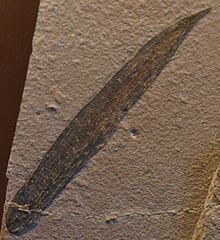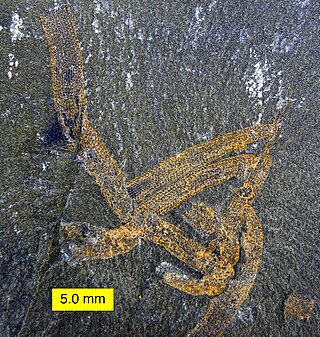
Vauxia is an extinct genus of demosponge that had a distinctive branching mode of growth. Each branch consisted of a network of strands. Vauxia also had a skeleton of spongin common to modern day sponges. Much like Choia and other sponges, Vauxia fed by extracting nutrients from the water.
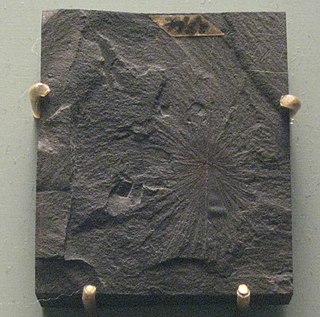
Choia is a genus of extinct demosponge ranging from the Cambrian until the Lower Ordovician periods. Fossils of Choia have been found in the Burgess Shale in British Columbia; the Maotianshan shales of China; the Wheeler Shale in Utah; and the Lower Ordovician Fezouata formation. It was first described in 1920 by Charles Doolittle Walcott.

Chancelloria is a genus of early animals known from the Middle Cambrian Burgess Shale, the Comley limestone, the Wheeler Shale, the Bright Angel Shale and elsewhere. It is named after Chancellor Peak. It was first described in 1920 by Charles Doolittle Walcott, who regarded them as one of the most primitive groups of sponges. However, they are currently thought to be member of the group Chancelloriidae. 178 specimens of Chancelloria are known from the Greater Phyllopod bed, where they comprise 0.34% of the community.

Eldonia is an extinct soft-bodied cambroernid best known from the Fossil Ridge outcrops of the Burgess Shale, particularly in the 'Great Eldonia layer' in the Walcott Quarry. In addition to over 550 specimens collected by Walcott, 224 specimens of Eldonia are known from the Greater Phyllopod bed, where they comprise 0.43% of the community. Species also occur in the Chengjiang biota, Siberia, and in Upper Ordovician strata of Morocco.

Hazelia is a genus of spicular Cambrian demosponge known from the Burgess Shale, the Marjum formation of Utah, and possibly Chengjiang. It was described by Charles Walcott in 1920.
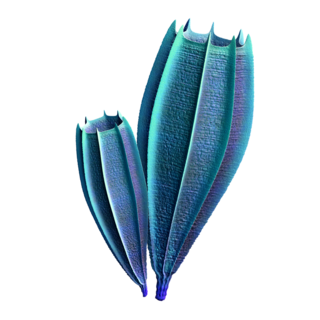
Takakkawia is a genus of sponge in the order Protomonaxonida and the family Takakkawiidae. It is known from the Middle Cambrian Burgess Shale that reached around 4 cm in height. Its structure comprises four columns of multi-rayed, organic spicules that align to form flanges. The spicules form blade-like structures, ornamented with concentric rings.
Cambrorhytium is an enigmatic fossil genus known from the Latham Shale (California), and the Chengjiang (China) and Burgess Shale lagerstätte. 350 specimens of Cambrorhytium are known from the Greater Phyllopod bed, where they comprise 0.7% of the community.
Acrothyra gregaria is a species of gregarious brachiopod known from the Middle Cambrian Burgess Shale. 253 specimens of Acrothyra are known from the Greater Phyllopod bed, where they comprise 0.5% of the community.

Eiffelia is an extinct genus of sponges known from the Middle Cambrian Burgess Shale as well as several Early Cambrian small shelly fossil deposits. It is named after Eiffel Peak, which was itself named after the Eiffel Tower. It was first described in 1920 by Charles Doolittle Walcott. It belongs in the Hexactinellid stem group. 60 specimens of Eiffelia are known from the Greater Phyllopod bed, where they comprise 0.11% of the community.
Fieldospongia is a genus of sea sponge known from the Middle Cambrian Burgess Shale. Just five specimens of Fieldospongia are known from the Greater Phyllopod bed, where they comprise less than 0.1% of the community.
Hamptonia is an extinct genus of sea sponge known from the Middle Cambrian Burgess Shale and the Lower Ordovician Fezouata formation. It was first described in 1920 by Charles Doolittle Walcott. 48 specimens of Hamptonia are known from the Greater Phyllopod bed, where they comprise < 0.1% of the community.

Lingulella is a genus of phosphatic-shelled brachiopod. It is known from the Middle Cambrian Burgess Shale (Canada) to the Upper Ordovician Bromide Formation in North America. 346 specimens of Lingulella are known from the Greater Phyllopod bed, where they comprise 0.66% of the community.
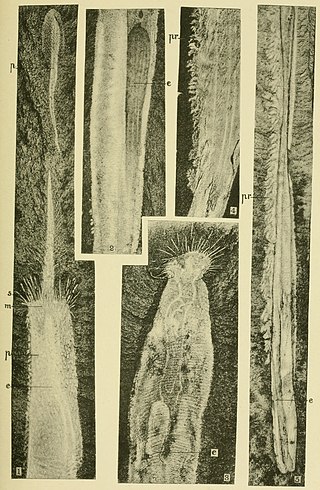
Louisella is a genus of worm known from the Middle Cambrian Burgess Shale. It was originally described by Charles Walcott in 1911 as a holothurian echinoderm, and represents a senior synonym of Miskoia, which was originally described as an annelid. 48 specimens of Louisella are known from the Greater Phyllopod bed, where they comprise < 0.1% of the community. It has been stated to have palaeoscolecid-like sclerites, though this is not in fact the case.

Leptomitus is a genus of demosponge known from the Middle Cambrian Burgess Shale. Its name is derived from the Greek lept ("slender") and mitos ("thread"), referring to the overall shape of the sponge. 138 specimens of Leptomitus are known from the Greater Phyllopod bed, where they comprise 0.26% of the community.

Pagetia is a genus of small trilobite, assigned to the Eodiscinid family Pagetiidae and which had global distribution during the Middle Cambrian. The genus contains 55 currently recognized species, each with limited spatial and temporal ranges.

Pirania is an extinct genus of sea sponge known from the Middle Cambrian Burgess Shale and the Ordovician Fezouata formation. It is named after Mount St. Piran, a mountain situated in the Bow River Valley in Banff National Park, Alberta. It was first described in 1920 by Charles Doolittle Walcott. 198 specimens of Pirania are known from the Greater Phyllopod bed, where they comprise 0.38% of the community.
Protospongia is a genus of Porifera known from the Middle Cambrian Burgess Shale. 102 specimens of Protospongia are known from the Greater Phyllopod bed, where they comprise 0.19% of the community.
Wapkia is an extinct genus of sea sponge with radial sclerites, known from the Middle Cambrian Burgess Shale. It was first described in 1920 by Charles Doolittle Walcott. 32 specimens of Wapkia are known from the Greater Phyllopod bed, where they comprise 0.06% of the community.

Hazeliidae is an extinct family of spicular Cambrian sea sponges known from the Burgess Shale, the Marjum Formation of Utah, and possibly Chengjiang. It was described by Charles Walcott in 1920.

Diagoniella is a genus of sponge known from the Middle Cambrian Burgess Shale. 128 specimens of Diagoniella are known from the Greater Phyllopod bed, where they comprise 0.24% of the community.
